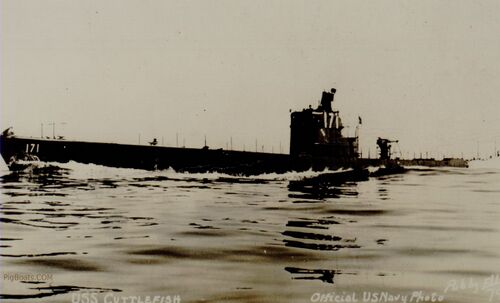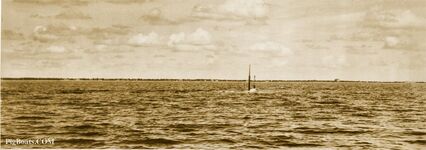171

Two officers are on the bridge saluting. It isn't know if this is the Commanding Officer LCDR Charles W. "Gin" Styer and his Executive Officer or maybe someone else. They appear to be a LCDR and a Lieutenant.
There are many children in the crowd viewing the launching regardless of that date being a Tuesday when they should have been in school. Perhaps it was part of a Thanksgiving vacation.
Original photo in the private collection of Ric Hedman.

At the center left on the deck edge is the hatch covering the mine cutting gear with the two holes and then one single hole to the right. This gear consisted of a swing out arm with a sharp saw-toothed edge that when rigged out set at an angle to the hull. There would also be a cable that would be attached to the leading end of the bow plans to deflect mine cables onto the cutting edge. Photos of this gear rigged out are extremely rare. By the start of the war, this gear was considered useless and it was removed.
Original photo in the private collection of Ric Hedman.

Original photo in the private collection of Ric Hedman. NOT a Navy photo. NOT in the public domain.

A fine shot of Cuttlefish while on sea trials. The image is date stamped on the back with March 27, 1934. Any location information has been lost. The submarine is anchored off a shoreline that may be almost anywhere off the New England coast but since she was an Electric Boat built submarine probably the Long Island Sound area. Her boarding ladder is partly lowered out of her after starboard superstructure. A number of men are seen standing around her 3"/50 caliber Mk 17 deck gun, maybe rigging the boarding ladder. Another sailor looks from around the conning tower fairwater forward. Below the "2"on the conning tower, on the side of the hull superstructure, are the rungs of an installed external ladder.
Original photo in the private collection of Ric Hedman.

Original photo in the private collection of Ric Hedman.

Another detail from the photo above. This detail shows the extended accomodation ladder used to ease transfer of personnel from and from small boats. Forward on the hull can be seen the four rungs of a permanently mounted ladder.
Original photo in the private collection of Ric Hedman.

Fifteen members of the crew, perhaps the duty section, are seen in this photo. The man in the center may be the Duty Officer, he is an Ensign. The man to his right is wearing a web belt and is probably the Topside Watch. The second and fourth men from the left are Chief Petty Officers. The man on the right at the bow seems to missing his ring finger on his left hand.
At the top of the radio mast flies her newly raised Commissioning Pennant. At the extreme left on the photo edge the US Flag is flying from the flag staff.
News Wire photo in the private collection of Ric Hedman.

NARA photo #19-N-15260, via Navsource.org
From a five photo framed collection in the private collection of Ric Hedman.


A fine shot of Cuttlefish underway at a moderate clip approximately 1934. It is likely she is entering port somewhere, but the exact location is not known. Line handling parties are in place on the forward and aft decks.
Her main radio mast is fully raised above the conning tower fairwater. The relatively low-powered radio sets of the day required a tall mast supporting long-line aerial wires in order to get the necessary transmission and reception ranges needed for operations far out to sea.
Photo from the United States Naval Observatory Collection.

U.S. Navy photo

The Lieutenant Commander seated directly above the ships life ring is Martin P. "Spike" Hottel, the submarine's Commanding Officer. To Hottel's right (photo left) is believed to be Lieutenant Millener W. Thomas, the Executive Officer. On the right of the seated officers is Lieutenant Junior Grade Leslie Kelly Taylor. Taylor joined the crew in July, 1939 and left the sub in February, 1942.
The man second from right, standing, is a Electricians Mate Second Class with one hash mark (meaning he has over 4 years of service completed). On his right sleeve he has a circle with cross hairs in it and a star above that. This means he was part of the gun team and was also a designated Gun Pointer First Class. This would have been a battle stations, gun action, position. At the bottom of this sleeve are his Qualified in Submarines insignia. You can see this same thing on others in the crew who have this part of their right sleeve visible.
On the far right in the back row with hand holding on to an overhead wire is one of the boat's two Mess Attendants; James Henry Washington MAtt/1C. Washington joined the crew in 1938 and left the sub in 1941. In this time frame of blatant segregation, it is rare to see a crew member of color included in in such a photo. As WW II progressed submarine crews were more inclusive as all the men were sharing the same combat experiences and proved their worth to each other.
Photo in the private collection of Ric Hedman.

U.S. Navy photo

Photo in the private collection of Ric Hedman.

The man in the foreground is shining his shoes. You don't do that during the "work day". The man on the bunk and the man with the coffee cup are talking. The sailor in the top bunk is reading a Zane Grey western novel called Wildfire. Western books were very popular with sailors and were still taken to sea in the 60's and 70's. The reader's shoes are sitting on the deck at the photos left.
There is no clear evidence, but the photo looks to be taken in the after battery berthing and looking aft. The door leading into what is most likely the crew's head or bathroom. The oval watertight door then whould lead into the engine room.
On the right edge of the photo is a bunk bag hanging from the triced up bunk. This bag was used to stow various items of clothing or towels or just about anything the sailor wanted to have at the ready. Personal storage space was at a premium so any extra space you could make for yourself was welcomed. This bag is made from cloth with a zipper. Modern bags are made from synthetic materials.
Behind the seated man on the right is a locker cabinet up against the bulkhead. There is probably a series of small lockers for men to use for personal items and clothing. The compartment was riddled with many of these small lockers all along the outer bulkheads between the bunks. The stack of bunks on the right is actually double sided with an identical stack of bunks on the opposite side, and then more bunks that mirror the bunks on the left in the photo. In all, this compartment would have between 36 to 40 bunks for crew.
Air conditioning outlets and duct work are seen at the top of the photo. By this time in the war all the older boats that were built without air conditioning, mainly the O, R and S class submarines, had been retro fitted. Air conditioning eliminated most of the condensation and humidity in submarines that contributed to electrical shorts and grounds, one of the biggest problems submarines had suffered since the beginning. A side benefit was the crew's morale was higher and people more comfortable aboard the vessel. The Cuttlefish was the first submarine to have such a system installed in 1935.
Photo in the private collection of Ric Hedman.

Photo in the private collection of Ric Hedman.

Photo in the private collection of Ric Hedman.
Page created by:
Ric Hedman & David Johnston
1999 - 2023 - PigBoats.COM©
Mountlake Terrace, WA, Norfolk, VA
webmaster at pigboats dot com




